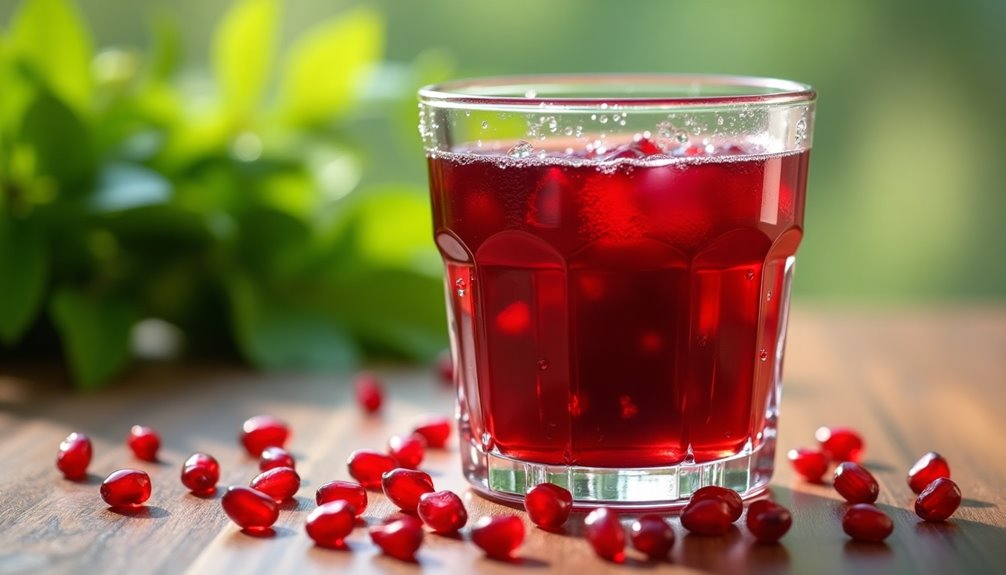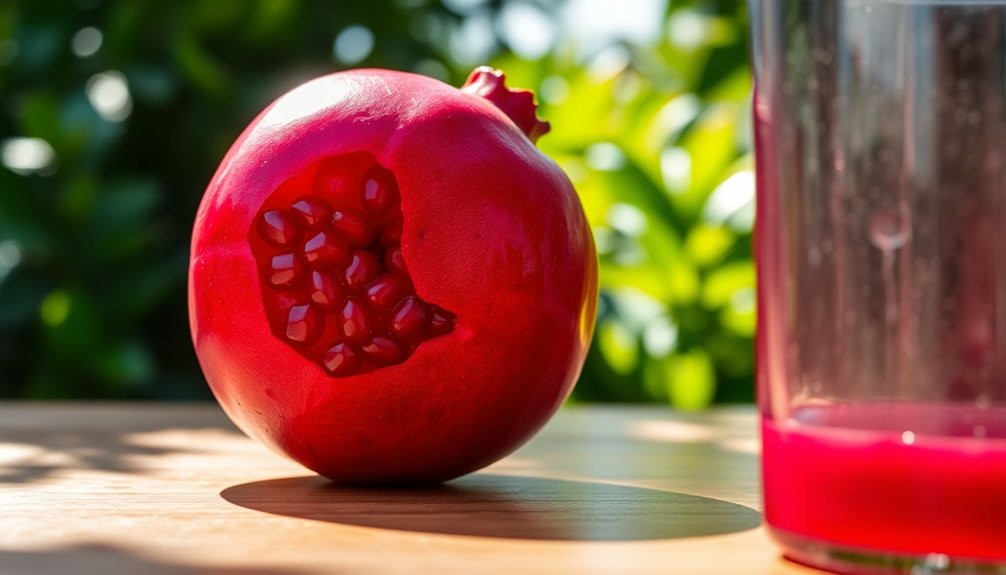Pomegranate juice prices can vary quite a bit, so you've got options. For example, a 16 Fl Oz bottle of POM Wonderful is around $3.13, while their 48 Fl Oz bottle costs about $9.96, making it more economical. If you prefer organic, Great Value offers a 32 Fl Oz bottle for $5.86. Keep in mind the size and brand can affect value, plus health benefits vary based on additives. You might find more useful information on choices and health benefits ahead.
Key Takeaways
- Pomegranate juice prices vary based on brand, size, and organic status, ranging from $3.13 to $9.96 for different bottle sizes.
- POM Wonderful 100% Pomegranate Juice costs $3.13 for a 16 Fl Oz bottle and $9.96 for a 48 Fl Oz bottle.
- Great Value Organic Pomegranate Juice is priced at $5.86 for a 32 Fl Oz bottle, appealing to health-conscious consumers.
- Larger bottles typically offer better value for regular consumers compared to smaller sizes.
- Always check labels for added sugars, as they can impact the juice's health benefits.

Have you ever wondered how much pomegranate juice really costs? If you're considering adding this delicious and nutritious drink to your diet, you might be surprised by the price variations you'll find on the market. Pomegranate juice can range significantly in price depending on the brand, size, and whether it's organic or not.
For instance, POM Wonderful 100% Pomegranate Juice is a popular choice, priced at $3.13 for a 16 Fl Oz bottle. It's a great option if you're looking to enjoy the wonderful benefits of pomegranates without breaking the bank.
If you want a larger quantity, the 48 Fl Oz bottle from POM Wonderful costs $9.96, which offers a more economical option for those who enjoy this juice regularly. This product is made from California pomegranates and is known for being non-GMO Project Verified, making it a reliable choice for health-conscious consumers.
However, keep an eye on the label for any added sugar, as some brands may include sweeteners that can affect the juice's health benefits.
Another option to consider is the Great Value Organic Pomegranate Juice, priced at $5.86 for a 32 Fl Oz bottle. This option is also organic, which means you're getting juice made from pomegranates that haven't been treated with synthetic pesticides.
It's a wonderful choice if you want to ensure that your drink aligns with organic standards while still being relatively affordable. When you compare it to POM Wonderful, you'll see that it offers a larger quantity for a slightly higher price.
It's fascinating to observe how price variations extend beyond just pomegranate juice. For example, Pomona Organic Juices offers an 8.4 Oz bottle of blackberry juice in a pack of 12 for $45.99. This highlights how different fruit juices can vary greatly in price, even within the organic category.
Additionally, if you're curious about other flavors, the IOS Love Organic Juice features a watermelon flavor sold at $59.95 for six bottles of 33.8 Fl Oz each.
When you're shopping for pomegranate juice, the options can feel overwhelming. You might want to assess your needs—whether you're looking for convenience, organic selections, or just something wonderful to sip on.
If you're only trying it out, you might go for the smaller bottle. But if you're a fan, opting for larger quantities might save you some money in the long run. Just remember to check for added sugar and ensure you're getting the full health benefits of the pomegranate.
Ultimately, pomegranate juice can be a delightful addition to your diet, with a range of prices to fit your budget. When choosing a brand, it’s essential to consider factors such as quality and added ingredients. Additionally, many people are curious about how much sugar is in juice; opting for varieties with no added sugars can make your choice even healthier, allowing you to enjoy the rich flavor without the extra calories.
Frequently Asked Questions
Is It OK to Drink Pomegranate Juice Everyday?
Yes, it's generally okay to drink pomegranate juice every day, as it offers beneficial antioxidants and supports your heart and immune health.
However, you should keep an eye on the sugar content, since an 8-ounce serving has about 32 grams.
Moderation is key, and if you have any health conditions, it's wise to consult your healthcare provider.
Enjoy the juice, but balance it with other nutritious options for a well-rounded diet!
Is POM Really 100% POMegranate Juice?
Yes, POM Wonderful is indeed 100% pomegranate juice.
You'll find that it's made from whole-pressed California-grown pomegranates, ensuring a pure product without fillers or added sugars.
When you sip it, you're getting a rich flavor that balances natural sweetness with a hint of tartness.
Plus, it's non-GMO and packed with antioxidants, making it a healthy choice for your daily routine.
Enjoy the genuine taste of pomegranate in every bottle!
Why Is Pomegranate Juice Expensive?
Pomegranate juice tends to be expensive due to its labor-intensive production process. Each fruit's handpicking
Is Pomegranate Juice Better Than Viagra?
When considering if pomegranate juice is better than Viagra, it's essential to look at their different benefits.
Pomegranate juice offers antioxidants that may improve blood flow and support overall cardiovascular health, potentially enhancing sexual function.
However, Viagra works specifically to increase blood flow to the penis.
While pomegranate juice can be a helpful addition to your diet, it's not a direct replacement for Viagra.
Always consult your healthcare provider for personalized advice.
Conclusion
In conclusion, the price of pomegranate juice can vary, but you might find it around $3 to $8 per bottle, depending on the brand and quality. Did you know that just one pomegranate can yield about 1 cup of juice? That's a great reason to enjoy this tasty drink! So, next time you're shopping, keep an eye out for those vibrant bottles; you're not just treating yourself, but also giving your health a boost.
Cindy thoroughly researches juicing trends, techniques, and recipes to provide readers with practical advice and inspiration. Her writing style is accessible, engaging, and designed to make complex concepts easy to understand. Cindy’s dedication to promoting the advantages of juicing shines through her work, empowering readers to make positive changes in their lives through the simple act of juicing.

















